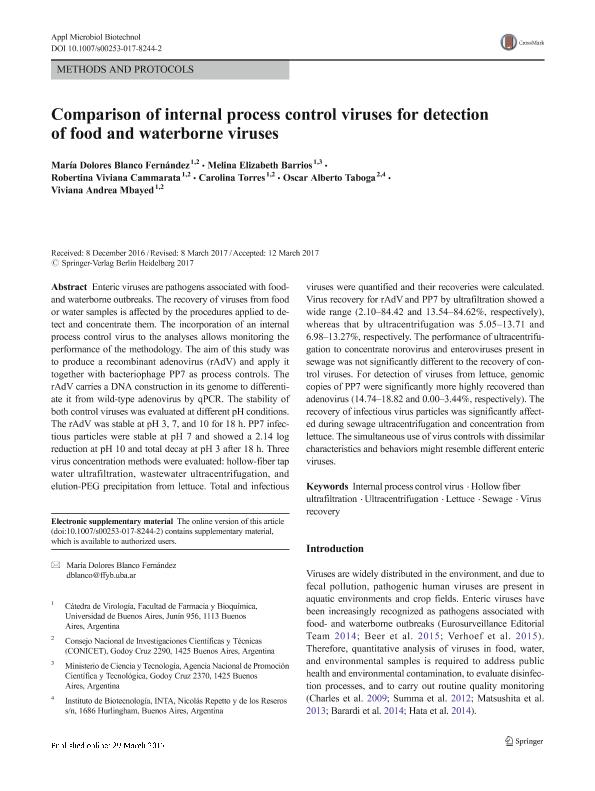Artículo
Comparison of internal process control viruses for detection of food and waterborne viruses
Blanco Fernandez, Maria Dolores ; Barrios, Melina Elizabeth
; Barrios, Melina Elizabeth ; Cammarata, Robertina Viviana
; Cammarata, Robertina Viviana ; Torres, Carolina
; Torres, Carolina ; Taboga, Oscar Alberto
; Taboga, Oscar Alberto ; Mbayed, Viviana Andrea
; Mbayed, Viviana Andrea
 ; Barrios, Melina Elizabeth
; Barrios, Melina Elizabeth ; Cammarata, Robertina Viviana
; Cammarata, Robertina Viviana ; Torres, Carolina
; Torres, Carolina ; Taboga, Oscar Alberto
; Taboga, Oscar Alberto ; Mbayed, Viviana Andrea
; Mbayed, Viviana Andrea
Fecha de publicación:
05/2017
Editorial:
Springer
Revista:
Applied Microbiology and Biotechnology
ISSN:
0175-7598
Idioma:
Inglés
Tipo de recurso:
Artículo publicado
Clasificación temática:
Resumen
Enteric viruses are pathogens associated with food- and waterborne outbreaks. The recovery of viruses from food or water samples is affected by the procedures applied to detect and concentrate them. The incorporation of an internal process control virus to the analyses allows monitoring the performance of the methodology. The aim of this study was to produce a recombinant adenovirus (rAdV) and apply it together with bacteriophage PP7 as process controls. The rAdV carries a DNA construction in its genome to differentiate it from wild-type adenovirus by qPCR. The stability of both control viruses was evaluated at different pH conditions. The rAdV was stable at pH 3, 7, and 10 for 18 h. PP7 infectious particles were stable at pH 7 and showed a 2.14 log reduction at pH 10 and total decay at pH 3 after 18 h. Three virus concentration methods were evaluated: hollow-fiber tap water ultrafiltration, wastewater ultracentrifugation, and elution-PEG precipitation from lettuce. Total and infectious viruses were quantified and their recoveries were calculated. Virus recovery for rAdV and PP7 by ultrafiltration showed a wide range (2.10?84.42 and 13.54?84.62%, respectively), whereas that by ultracentrifugation was 5.05?13.71 and 6.98?13.27%, respectively. The performance of ultracentrifugation to concentrate norovirus and enteroviruses present in sewage was not significantly different to the recovery of control viruses. For detection of viruses from lettuce, genomic copies of PP7 were significantly more highly recovered than adenovirus (14.74?18.82 and 0.00?3.44%, respectively). The recovery of infectious virus particles was significantly affected during sewage ultracentrifugation and concentration from lettuce. The simultaneous use of virus controls with dissimilar characteristics and behaviors might resemble different enteric viruses.
Archivos asociados
Licencia
Identificadores
Colecciones
Articulos(OCA HOUSSAY)
Articulos de OFICINA DE COORDINACION ADMINISTRATIVA HOUSSAY
Articulos de OFICINA DE COORDINACION ADMINISTRATIVA HOUSSAY
Citación
Blanco Fernandez, Maria Dolores; Barrios, Melina Elizabeth; Cammarata, Robertina Viviana; Torres, Carolina; Taboga, Oscar Alberto; et al.; Comparison of internal process control viruses for detection of food and waterborne viruses; Springer; Applied Microbiology and Biotechnology; 101; 10; 5-2017; 4289-4298
Compartir
Altmétricas



